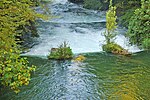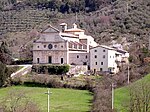Ferentillo
Castles in ItalyCities and towns in UmbriaMunicipalities of the Province of Terni

Ferentillo is a comune (municipality) in the Province of Terni in the Italian region Umbria, located about 60 km southeast of Perugia and about 12 km northeast of Terni. The comune, located in the valley of the Nera, is divided by the river into the burghs of Matterella and Precetto. Ferentillo borders the following municipalities: Arrone, Leonessa, Montefranco, Monteleone di Spoleto, Polino, Scheggino, Spoleto.
Excerpt from the Wikipedia article Ferentillo (License: CC BY-SA 3.0, Authors, Images).Ferentillo
Geographical coordinates (GPS) Address Nearby Places Show on map
Geographical coordinates (GPS)
| Latitude | Longitude |
|---|---|
| N 42.616666666667 ° | E 12.783333333333 ° |
Address
05034
Umbria, Italy
Open on Google Maps











